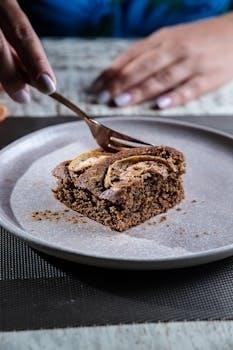A 6-inch cake is perfect for small gatherings or holidays. This guide provides information to master the art of dividing it into perfect portions. Whether round or square, learn how to cut this delightful treat for any occasion.
Determining the Number of Servings
The number of servings from a 6-inch cake depends on slice size and cake height. A 6-inch round cake can yield between 5 and 11 servings. Adjust based on whether you want party or wedding-sized slices.
Factors Affecting Servings (Cake Height, Slice Size)
Several factors influence the number of servings you can get from a 6-inch cake. Primarily, the cake’s height plays a significant role. A taller cake allows for thinner slices, yielding more servings. Slice size is another crucial determinant; smaller slices increase the overall number of portions. For instance, wedding servings are typically smaller than party servings.
Taller cakes, often three-layered, can be sliced into tall rectangles and then halved widthwise to maximize the number of servings. Conversely, shorter cakes may be cut into wider slices to ensure each serving is substantial. Ultimately, consider the occasion and desired portion size to determine how to best cut your 6-inch cake.
Standard Serving Sizes for a 6-Inch Cake
A 6-inch cake typically serves between 6 to 11 people. This depends on slice size and cake height. Knowing standard sizes helps plan portions effectively for any gathering.
Party Servings vs. Wedding Servings
When considering servings, distinguish between party and wedding needs. Party servings are larger, reflecting smaller guest lists. A typical party slice might be 4 inches tall, 2 inches wide, and 1 inch deep, or a triangle 2 inches wide. Wedding servings are smaller, prioritizing maximizing portions for larger gatherings. Wedding slices are commonly 4 inches tall, 1 inch wide, and 1 inch deep. For taller cakes, wedding servings are often halved widthwise. Understanding this difference helps you cut your 6-inch cake appropriately, ensuring all guests are accommodated, whether at a casual party or a formal wedding.
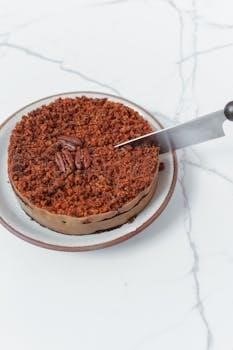
Cutting a Round 6-Inch Cake
Slicing a round cake requires precision to ensure even portions. Whether aiming for generous or standard servings, mastering the technique guarantees everyone enjoys a delightful piece. Achieve aesthetically pleasing slices every time.
Slicing into Equal Pieces
Achieving equal slices in a round 6-inch cake is essential for fair distribution. Start by identifying the center and making a straight cut across the diameter. Rotate the cake 90 degrees and repeat, dividing it into four equal parts. These quarters can then be halved or further divided depending on the desired serving size.
For smaller portions, create concentric circles within the cake, then cut from the center outwards. Visual guides or cake serving charts can aid in accurate portioning. Consistent cutting ensures each piece is uniform, enhancing the overall presentation and enjoyment.
Cutting a Square 6-Inch Cake
Cutting a square 6-inch cake offers unique serving options. Its shape allows for neat, uniform slices, making it ideal for maximizing servings. Learn effective techniques to divide this cake evenly and efficiently for any gathering.
Maximizing Servings from a Square Cake
A square cake allows for more efficient cutting, especially when aiming for a higher number of servings. Start by cutting the cake into a grid pattern. This method ensures uniform slices and minimizes waste. For a 6-inch square cake, consider cutting it into smaller squares or rectangles, depending on the desired serving size.
Aim for slices that are approximately 1 inch wide, which is a standard serving size. This approach can yield between 10 to 12 servings. Adjust the grid size based on whether you need party or wedding-sized portions, ensuring everyone enjoys a piece.
Step-by-Step Cutting Guide
Follow our detailed instructions for perfectly portioned cake slices every time. Learn the best techniques for both round and square 6-inch cakes. Achieve neat, even servings with ease, enhancing your presentation.
Starting Point and Cutting Techniques
Begin by ensuring your cake is well-chilled for cleaner cuts. For a round cake, visualize a star pattern, cutting from the center outwards to achieve uniform slices. Alternatively, cut concentric circles for smaller, more numerous servings. For square cakes, slice straight lines across and down to create equal squares or rectangles.
Use a long, serrated knife for best results. Gently saw through the cake, avoiding downward pressure. Wipe the knife between slices for a clean presentation. Consider the event – weddings require thinner slices, while parties allow for larger portions. Adjust your cutting technique to suit the occasion and desired serving size. Proper cutting ensures everyone enjoys a delightful piece.
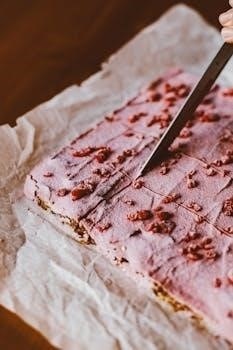
Visual Examples of Cake Slices
Visual aids can greatly assist in understanding optimal cake-cutting techniques. Imagine perfectly portioned triangles radiating from the center of a round cake, each slice showcasing layers and frosting. Envision neat squares extracted from a square cake, maximizing servings and minimizing waste.
Consider diagrams illustrating both wedding and party serving sizes, demonstrating the difference in slice thickness. Look for examples showing the clean lines achieved with proper knife techniques. Observe how different cutting patterns affect the presentation of the cake.
Online resources often provide photographs and videos that visually demonstrate these techniques. Studying these examples will empower you to confidently cut your 6-inch cake with precision and style, ensuring every slice is a delectable masterpiece.
Cake Serving Charts and Guides
Cake serving charts offer a quick reference for portioning. These guides help determine the number of slices based on cake size. Utilize charts for accurate and consistent serving sizes, ensuring everyone enjoys a piece.
Using Charts for Accurate Portioning
Cake serving charts are invaluable tools when aiming for precise and consistent portion sizes. These charts typically outline the recommended number of servings based on the cake’s dimensions, whether it’s a 6-inch round or square cake. By consulting these charts, bakers and hosts can effectively plan and manage servings for any event, from intimate gatherings to larger parties.
Using a cake serving chart ensures that everyone receives a fair share, minimizing waste and maximizing satisfaction. These charts consider factors such as cake height and layer configuration to provide accurate estimates. Referencing a serving chart eliminates guesswork and helps create a seamless and enjoyable experience for all.
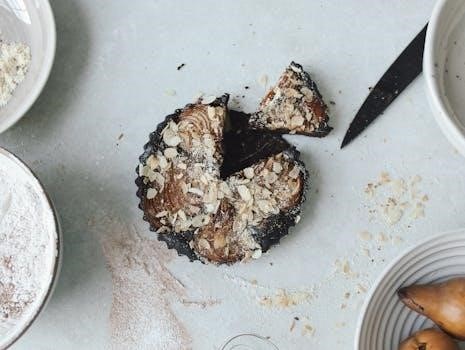
Tips for Neat and Clean Cutting
Achieving a clean, professional cut enhances the presentation of your cake. Proper knife selection and preparation are key. Explore techniques to ensure each slice is perfect, maintaining the cake’s integrity and visual appeal.
Knife Selection and Preparation
Selecting the right knife is crucial for achieving neat cake slices. A long, thin, serrated knife, often called a bread knife, works best for cutting through cake layers without tearing them. Alternatively, a large, sharp chef’s knife can also be used effectively. Prior to cutting, ensure the knife is clean and dry.
For exceptionally clean cuts, consider warming the knife under hot water and drying it thoroughly between each slice. This helps the knife glide through the cake more smoothly, preventing the frosting from sticking and creating a mess. Clean the knife frequently during the cutting process to maintain presentation.
Adjusting for Cake Height and Layers
Cake height and multiple layers influence how you approach cutting. Taller cakes may require different slicing techniques to ensure stability and even portions. Adapt your cutting strategy based on the cake’s structure.
Cutting Taller Cakes
When faced with a taller cake, the standard wedge method might not be the most practical. For cakes exceeding 4 inches in height, consider a method used for wedding servings. Initially, cut tall rectangles that span the height of the cake, approximately 4 inches tall and 1 inch wide. For easier handling and serving, these rectangles can then be sliced in half horizontally. This technique maintains portion control while ensuring the cake remains structurally sound. Remember, the taller the cake, the thinner you’ll likely want to slice each piece to avoid overly large servings.
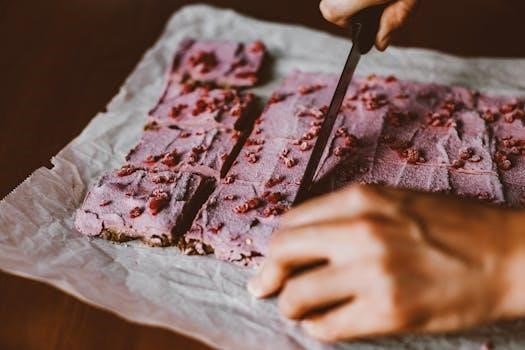
Additional Resources
Explore further with cake recipes, frosting guides, and scaling techniques. Discover online tutorials for cake decorating and serving. These resources will enhance your cake-making and presentation skills for any event.
Cake Recipes and Frosting Guides
Discover a variety of cake recipes tailored for 6-inch pans, ensuring the perfect batter amount for optimal results. Explore frosting guides to complement your cake, with recipes for buttercream, ganache, and more. These guides offer insights into achieving the right consistency and flavor pairings.
Find resources that provide step-by-step instructions for baking and frosting, catering to different skill levels. Learn about gluten-free, dairy-free, and vegan options to accommodate dietary needs. Enhance your baking repertoire with these curated cake and frosting guides.
Whether you’re a novice or experienced baker, these resources will help you create delicious and visually appealing 6-inch cakes for any occasion.
